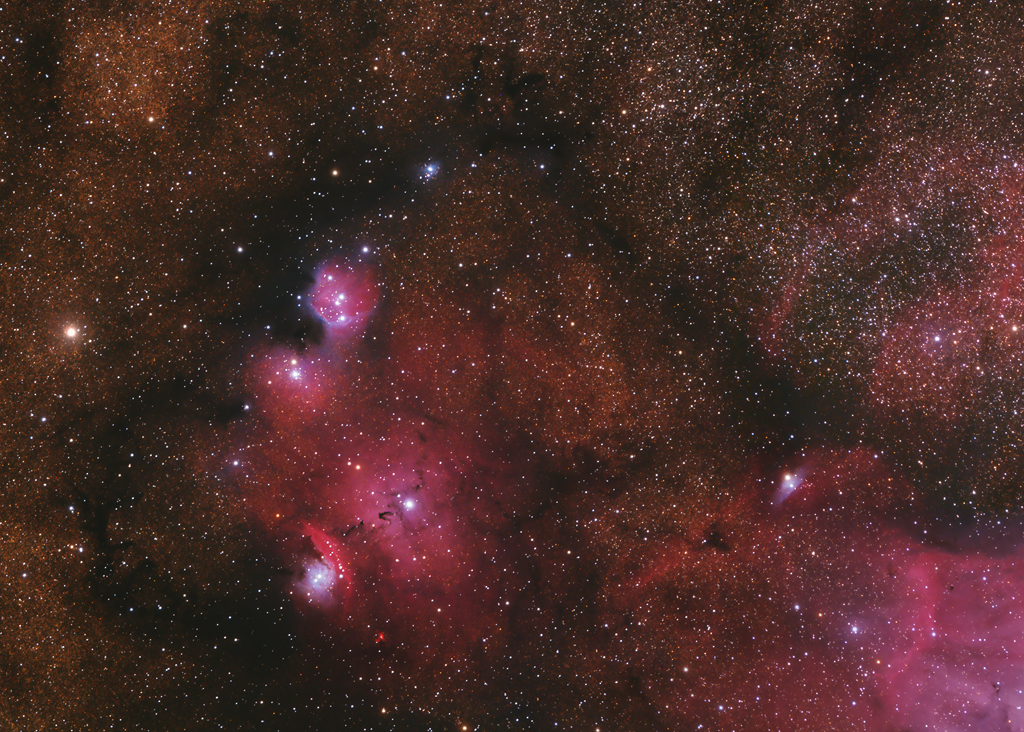 |
CHAMÄLEON + ONJALA OBSERVATORY DeepSky | SITEMAP HOME CHAMÄLEON |
|
 |
|||
| « back to overview Nebula | Load higher resolution (1800 x 1400 Pixel 2500 x 1800 Pixel) | Object description |

Our image shows a H-II star forming region in the constellation Sagittarius, catalogued as Simeis 188 or Sharpless 29 and LBN 33. It lies not far east of the Lagoon Nebula, Messier 8. The region contains the separate nebular parts NGC 6559 and IC 4685, 1274 and 1275 and shows all 3 forms of galactic nebulae: emission, reflection nebulae and dark clouds. The distance to the solar system is about 5500 light years.
When interstellar dust and gas clouds of hot young stars are illuminated with strong ultraviolet light, it starts to glow brightly due to the absorbed energy. The diffuse red glow in the image is caused by emission of hydrogen gas, while the blue nebular parts are due to reflection and scattering of small dust particles. In addition to emission and reflection, absorption also occurs in this region. Dark nebula - cool dust accumulations block the light from the stars that are behind the dust accumulations.
The extremely young and massive blue stars in our picture are only 1 to 2 million years old and have only a short life. In a few million years they will end their life as a supernova explosion and thereby drive apart the surrounding gas and dust clouds. In several tens of millions of years the colorful nebula region will be gone and only some open star clusters will remain.
In the center of the H-II region IC 4685 is HD 165 921, an eclipsing binary star of spectral classes O. From these two stars comes a large part of the UV radiation, which makes the hydrogen gas of the nebula glow reddish. The snake-like dark nebula to the east (left) of the star is classified as Barnard 303.
To the southeast is the very active star-forming region NGC 6559, and it is mixed with blue reflection nebulae. NGC 6559 is the brightest part of Sharpless 29 and was discovered visually by John Herschel on July 31, 1826. All other nebulae were photographed by Edward Emerson Barnard on June 25, 1892 discovered.
 |
North
of IC 4685 lies the star forming region LBN 33. The brighter nebular parts have
the catalog names IC 1274 and IC 1275. IC 1274 contains a young open star
cluster with 4 blue giant stars. A detailed scientific publication of IC 1274
can be found here. South of HD 165 921 and NGC 6559 lies the planetary nebula Minkowski 1-41 (PK 006.7-02.2), which is only 10 arcseconds in size. A description of Sharpless 29 by ESO can be found here and a mosaic of the whole region, together with Messier 8 and Messier 20, we show here. « Click here or the thumbnail to load a large annoted image . |
 |
 |
 |
 |
 |
 |
 |
| Sun | Moon | Solar System | DeepSky | Widefield | Miscellaneous | Spec. Projects |